Upanishads – A tool for self discovery
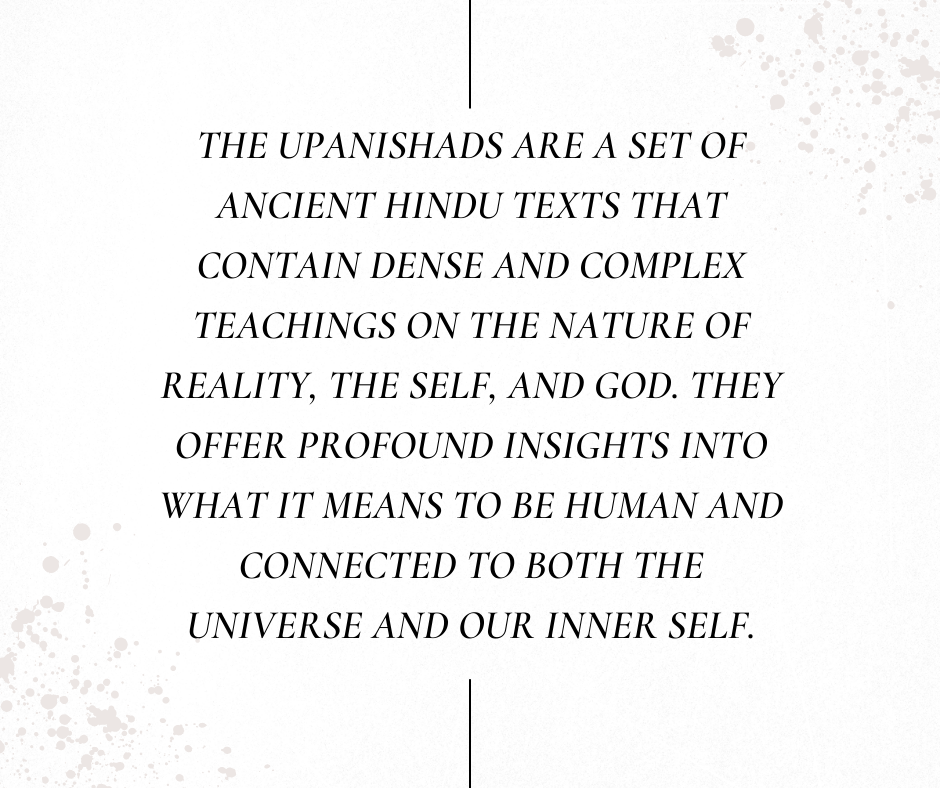
One of the central teachings of the Upanishads is that there is a self within us that is eternal and unchanging. This Self is our true nature, and it is awareness of this Self that allows us to find peace and happiness. The Upanishads also teach that there is a divine force or God behind all things, and that we can connect with this God by knowing and understanding ourselves. By studying the teachings of the Upanishads, we can develop a deeper understanding of who we are and where we come from. It is through exploring our own inner self that we can begin to find joy and happiness in life.
Learning about these concepts can be difficult, but they are well worth exploration if we want to live meaningful lives. The Upanishads provide a comprehensive perspective on reality that can help us understand our place in the world and reach inner peace. So, if you’re interested in discovering more about yourself, the universe, or God – the Upanishads are definitely a good place to start!
What are the Upanishads?
Upanishads are a part of Hindu religious Indian literature. Upanishads are also described as Vedantha or Uttara Mimamsa. Upanishads, in general, represent the conclusion of the Vedas.
The Upanishads are a collection of philosophical texts that form the basis of the Hindu religion. The word “Upanishad” is a Sanskrit word that can be translated to mean “sitting down near” or “secret doctrine”, reflecting their origin in ancient times when they were passed down orally from guru to student.
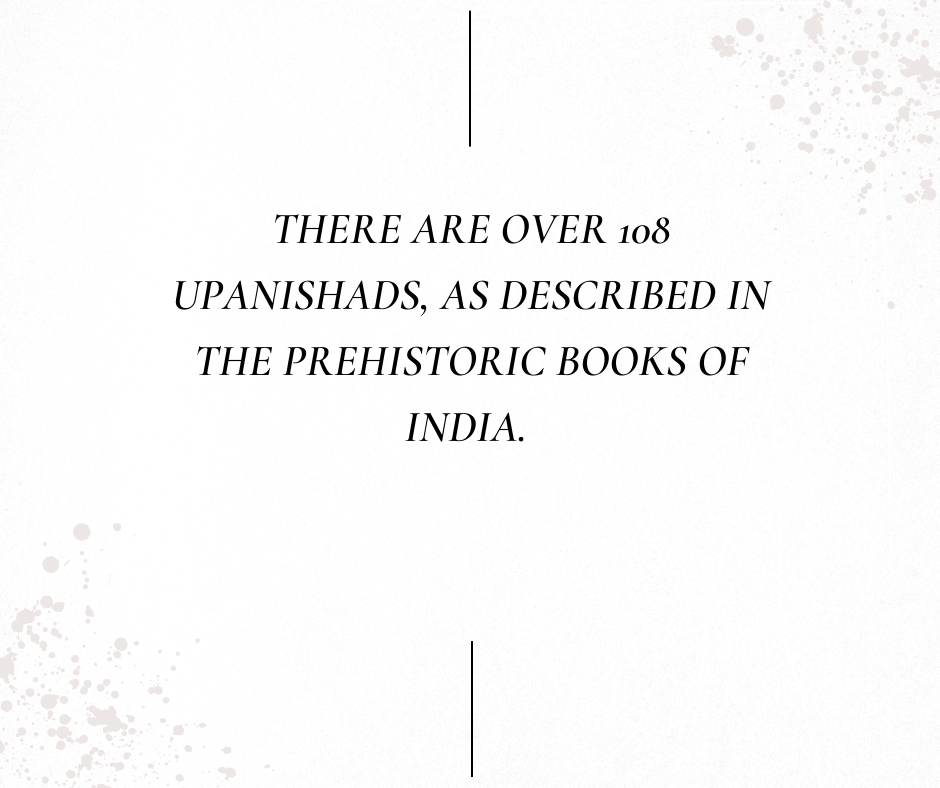
Central Ideas of Upanishadic Thought
There are many ideas which are considered as central to Upanishadic thought: Brahman, Maya, Jiva, Karma, Samsara and Moksha.
You may have heard of these terms before, but did you know that they’re the central ideas of Upanishadic thought?
Brahman is the one reality. It exists in three forms: Vidya (knowledge), Avidya (ignorance) and Maya or Prakriti. It is a pure state which only becomes manifest due to ignorance; it does not have parts or qualities and cannot be described using words or symbols. The individual soul is called Jiva, meaning ‘life’, as it is separate from this world with its own self-consciousness.
Karma refers to both cause and effect; when an action causes something else to happen down the line, that action is called karma—and if there are no consequences for your actions then you don’t have any karma! Samsara means “flow” or “cycle”; samsara means “birth-death-rebirth” over and over again until someone breaks free from their cycle by realizing Brahman through meditation practices like yoga.
The Upanishads have been translated into English and many other languages, but there is no one single English translation. There are different translations of different Upanishads because they each contain unique ideas and teachings.
The most important idea in the Upanishads is ‘Brahman’. In Hinduism, Brahman is that one reality which pervades everything existing in the universe. It is the existence-knowledge-bliss Absolute. It constitutes everything: matter (prakrti), consciousness (Purusha) and all phenomena (Maya).
We can consider a scenario to understand this. Let’s say a student approaches a Guru seeking self-transformation. That Guru’s wisdom is so remarkable that it triggers hope in the student. Due to that, the student walks the path sincerely and discovers their truth.
Such a student makes the Guru’s cause successful. Hence, the student becomes the Guru’s spiritual friend, Sahadharmin or Sahadharmini. If noted down, that Guru’s wisdom is an Upanishad! It elevated their student to “sit together” in spiritual status with them.
For instance, Sri Ramakrishna Paramahansa had two such students. One was Sri Maa Sharada Devi, who became his Sahadharmini. Then, Swami Vivekananda matured into his Sahadharmin. So, both of their pictures sit together with their Guru.
Source: An introduction to Upanishads
If someone wants to study the Vedas, they should study the Upanishads first. The essence of Vedas can be found in the Upanishads, which is focused on the philosophy of life. Followed by the Upanishads, one can read the Puranas. The Puranas will help when you start to study the Vedas. Studying the Vedas is for someone who has plenty of time, a great deal of willingness, some degree of devotion, and a lot of self-discipline. Today, the first challenge for anybody studying the Vedas would be to get the right translations – Om Swami. Watch Om Swami sharing insights on learning Vedic literature.
Essence of Upanishads
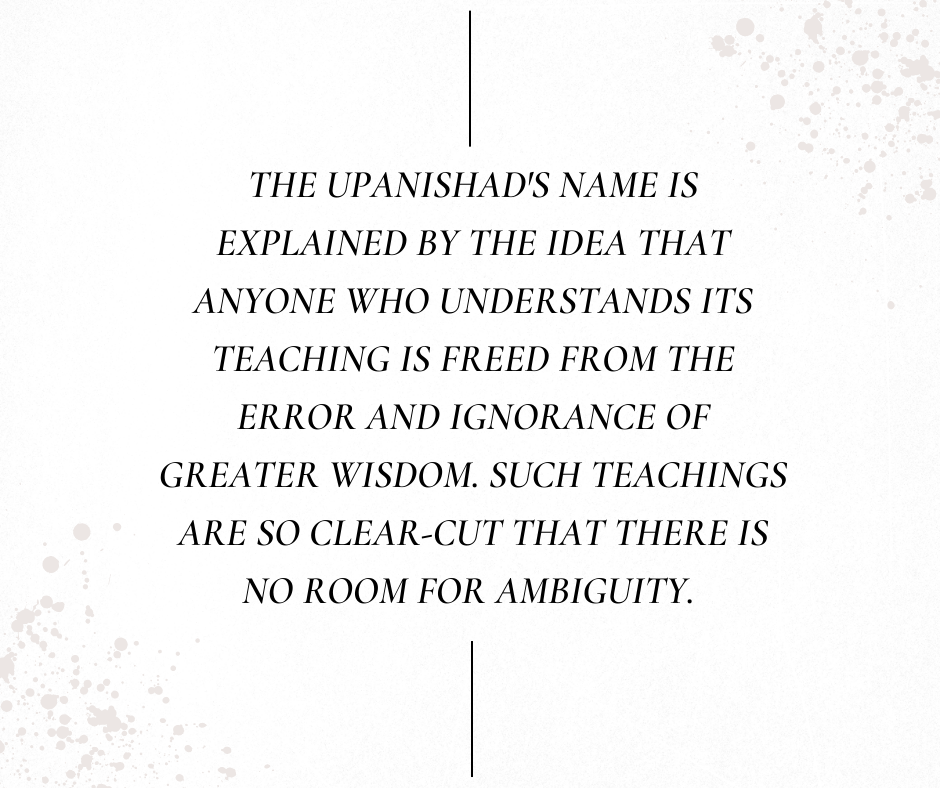
There are four Vedas in total. They are Rig Veda, Yajus Veda, Sama Veda, Atharva Veda. These four Vedas are comprised of 4 sections:
- Samhita
- Brahmanas
- Aranyakas
- Upanishads
Of which the fourth, Upanishads are the essence of Vedas. The knowledge part of the Vedic texts is also known as the Jnana Kanda. It also goes by the name Vedantha because it constitutes the final section of the Vedas.
The word ‘Veda’ implies learning. Hence the term Vedantha can also be used to describe the total of all knowledge; A person who has read, comprehended, and internalized the Vedantha has attained his objective of realizing the supreme self.
It also goes by the name Para Vidya because of this. The following four principles, Mahakavyas from Upanishads, can be used to describe the essence of Sanatana Dharma:
- Aham Brahma Asmi– I’m Brahman (Brihadaranyaka Upanishad 1.4.10)
- Tat Tvam Asi– You are that Brahmin (Chandogya Upanishad 6.8.7)
- Ayam Atma Brahma– The individual self is Brahman ((mundaka Upanishad 2.)
- Prajnanam Brahma– Supreme knowledge is Brahman ( (Aitareya Upanishad 3.1.3)
Among all the Upanishads, only twelve are the most important. Brihadaranyaka is the greatest Upanishad and is a major part of Yajur Veda.
The essence of Sanatana Dharma (Also known as Hindusim) can be described with help of below Four Principle Mahavakyas from Upanishad’s
Each one of us has built our own reality. The laws of physics point out that the brain is responsible for the reality we perceive for our emotions and its meaning too. Love and honor, right and wrong are part of the universe we create in our mind.
The radical thinkers of science may not need the guidance of religious texts, the scriptures of the past surely do not need the validation of science. It is just the ego of feebly learned people that draws out an argument of one against another but follows neither.
It is your creation; you are its maker. Give it the love to grow, give it the care to sustain, treat it the way as you treat yourself.
Brihadaranyaka Upanishad 5.1.1
ॐ पूर्णमदः पूर्णमिदम् पूर्णात् पूर्णमुदच्यते |
पूर्णस्य पूर्णमादाय पूर्णमेवावशिष्यते ||
ॐ शान्तिः शान्तिः शान्तिः ||Oṃ pūrṇamadaḥ pūrṇamidam pūrṇāt pūrṇamudacyate
pūrṇasya pūrṇamādāya pūrṇamevāvaśiṣyate
oṃ śāntiḥ śāntiḥ śāntiḥThis (the Bramham ) is complete, that (The universe) is complete, from complete has emerged complete, when you take complete out of complete, what is left is also complete.
Categories of Upanishads
And they are categorized into five Vedic scriptures, i.e., Rig, Sama, Shukla or White Yajur, Krishna or Black Yajur, and Atharva. They are distributed into these five scriptures, which are further categorized in 2 ways:
Veda of Affliction: Based on its topic, each Upanishad is attached to one of the five Vedic scriptures. Those are the Rig, Sama, Shukla or White Yajur, Krishna or Black Yajur, and Atharva.
Taking the traditional 108 Upanishads, below is their count by their Vedic affiliation:
- Rig Veda: 10 Texts
- Sama Veda: 16 Texts
- Shukla Yajur Veda: 19 Texts
- Krishna Yajur Veda: 32 Texts
- Atharva Veda: 31 Texts
Based on the weightage and Sub-traditions
Each Upanishad is also tagged based on their topics’ weightage or subtradition. Some texts cover many ideas. So, their tagging may vary depending on the classifier. Hence, the below-presented counts are a rough estimate.
Taking the traditional 108 Upanishads, here’s the typical categorization and counts:
- Mukhya or Principal/Major Upanishads: A count of 10 texts that cover the essential topics.
- Samaanya or General/Minor Upanishads: A count of 24 texts that contain general ideas. These don’t focus on any particular sub-tradition. Sometimes, 3 of these texts get listed as Mukhya Upanishad.
- Sanyasa Upanishads: These focus on Sanyasa or the life of a renunciate. It roughly includes about 17 texts.
- Shakta Upanishads: A count of 9 Upanishads contain topics related to Devi worship.
- Vaishnava Upanishads: A count of 14 texts that speak about Vishnu worship.
- Shaiva Upanishads: A count of 14 texts that talk about the sub-tradition of Shiva worship.
- Yoga Upanishads: These texts contain information about Yogic practices. These aim at leading us towards union with the Divine. There are 20 Upanishads tagged as Yoga.Source: An introduction to the Upanishads
12 basic principals Upanishads
There are 108 Upanishads in Hindu Mythology, and they form the basis of the supreme truth of the world.
Mundaka Upanishad:
Mundaka Upanishad is the smallest of all the Upanishads. Yet it is described as the most powerful Upanishad. The term “Mundaka” refers to a shaving razor and a monk with a shaved head.
The Upanishads contain Shanti Mantras that are chanted to attain peace in all walks of life.
The Mundaka Upanishad is categorized into three dividends, each of which has two sections:
- The first Mundakam puts light on the higher and lower knowledge and teaches that it’s not happiness but the knowledge that frees us from the hypnosis of social conditioning.
- The second Mundakam pours the concept of self or the Brahman and teaches the oath to discover oneself.
- The third Mundakam elaborates on the concepts presented in the second Mundakam before claiming that knowing Brahman is a state of freedom, fearlessness, total liberation, self-sufficiency, and bliss.
Thirteen of the Upanishads, a collection of books compiled from oral traditions, contain the core ideas of Hindu philosophy. One of the most translated basic Upanishads is the “Mundaka Upanishad,” which is a part of the “Atharva Veda.”
Kena Upanishad:
The word “Kena” means by whom in the Upanishad, is where the Kena Upanishad gets its name. Who created this world, exactly?
- Who made it possible for this existence to exist?
- Who controls our bodies and minds? It is said that the prana is the basis of everything, and it is the most potent material that contains everything.
- But is there a power higher than prana?
Kena Upanishad provides the answer to this question. It says that the self or atman is the highest power of all. It is amazingly described through a story how the divine self that gave the powers could also take away the forces.
There is only one Brahman. The body, senses, and mind are erroneously projected over it, much like an imaginary serpent on a rope. The genuine essence and self of the illusory snake is the rope, just as the true essence and self of the eye, speech, mind, and everything else are Brahman. It cannot be reduced to an object by the material and limited senses.
Chandogya Upanishad
One of the most well-known and frequently read Upanishads is the Chandogya Upanishad. It relates to the tale of a father enlightening his son about Hinduism’s ( Sanatan Dharma) fundamental principles.
There lived once a boy named Svetaketu Âruneya. To him his father said: ‘Svetaketu, go to school; for there is none belonging to our caste, darling, who, not having studied (the Vedas), is, as it were, a Brahmin by birth only.’
Having begun his apprenticeship (with a teacher) when he was twelve years of age Svetaketu returned to his father when he was twenty-four, having then studied all the Vedas,–conceited, considering himself well-read, and stern.
His father said to him: ‘Svetaketu, as you are so conceited, considering yourself so well-read, and so stern, my dear, have you ever asked for that instruction by which we hear what cannot be heard, by which we perceive what cannot be perceived, by which we know what cannot be known?’
‘What is that instruction, Sir?’ he asked.
The father replied: ‘My dear, as by one clod of clay all that is made of clay is known, the difference being only a name, arising from speech, but the truth being that all is clay;
‘And as, my dear, by one nugget of gold, all that is made of gold is known, the difference being only a name, arising from speech, but the truth being that all is gold?
‘And as, my dear, by one pair of nail-scissors all that is made of iron is known, the difference being only a name, arising from speech, but the truth being that all is iron,–thus, my dear, is that instruction.’
The son said: ‘Surely those venerable men (my teachers) did not know that. For if they had known it, why should they not have told it me? Do you, Sir, therefore tell me that.’ ‘Be it so,’ said the father.
‘Fetch me from thence a fruit of the Nyagrodha tree.’
‘Here is one, Sir.’ Break it.’
‘It is broken, Sir.’
‘What do you see there?’
‘These seeds, almost infinitesimal.’
‘Break one of them.’
‘It is broken, Sir.’
‘What do you see there?’
‘Not anything, Sir.’
The father said: ‘My son, that subtle essence which you do not see there, of that very essence this great Nyagrodha tree exists.
‘Believe it, my son. That which is the subtle essence, in it all that exists has its self. It is the True. It is the Self, and thou, O Svetaketu, art That.’
‘Please, Sir, inform me still more,’ said the son. ‘Be it so, my child,’ the father replied.
‘Place this salt in water, and then bring it to me in the morning.’
The son did as he was commanded.
The father said to him: ‘Bring me the salt, which you placed in the water last night.’
The son having looked for it, found it not, for, of course, it was dissolved.
The father said: ‘Taste it from the surface of the water. How is it?’
The son replied: ‘It is salty.’
‘Taste it from the middle. How is it?’
The son replied: ‘It is salty.’
‘Taste it from the bottom. How is it?’
The son replied ‘It is salty.’
The father said Throw it away and then come back to me.’
He did so; but salt exists for ever.
Then the father said: ‘Here also, in this body, forsooth, you do not perceive the True (Sat), my son; but there indeed it is.
‘That which is the subtle essence, in it all that exists has its self. It is the True. It is the Self, and thou, O Svetaketu, art That.’
The father sends the son away to study the Vedas with a pious teacher at the beginning of the Upanishad. The Brahmin caste had a custom like this. The boy has been learning the Vedas for 12 years.
The father then teaches the boy about the fundamental unity of everything in the universe. To do his thesis, he gives examples of various other elements, including clay, gold, and iron. Because they are all the same, despite their distinctions, he claims that if you know one of these components, you know them all.
In Hinduism, differences are only apparent on the surface and apply to everything in the world. Everything is Brahman, and everything is one since everything contains the holy essence.
Chandogya Upanishad deals with the concept “The body is the self.” this is beautifully described in a story where Indra and Virocana approach Brahaspathi to seek self-knowledge. After long years they attain the knowledge and realize that Atma (soul) is everything, and it is unconditional, calm, and dual.
Mandukya Upanishad
The Mandukya Upanishad is one of the core Upanishads to enhance your understanding of Advaita Vedanta. When Advaita Vedanta talks about god, it does not make easy promises to people. Here are some of the most common questions people have about finding the divine.
- Where do I find God — Most traditional religions say you can find god in heaven.
- When do I find God — Most traditional religions say that you can find him after you die.
- How do I find God — Most traditional religions talk about finding god through service or bhakti.
Advaita Vedanta makes a very bold claim. It states that you are looking for infinite consciousness, also called God or Brahman, and you can find it in the here and the now if you know how to look.
Source: Finding God
All other written and oral teachings can be examined as extensions of the fundamental concepts and practices condensed in this concise overview by carefully and obediently studying the twelve verses.
Gaudapada, a philosopher and scholar of Advaita Vedantha of Hindu philosophy, has written an expansion on Mandukya Upanishad called Mandukya Karika.
It says, “There is neither dissolution, nor birth; neither anyone in bondage, nor any aspirant for wisdom; neither can there be anyone who hankers after liberation, nor any Liberated as such. This alone is Supreme Truth (177). Every home is a temple.
The life of a householder is a sadhana. You often cannot do what you want to because you will have to see the wants of your husband, children, neighbor, or country. You may have to sacrifice your little desires no matter how important . We have to do this sadhana there is no other way…there should not be any frustuation”
Source: When Nature guides you
One of the major short Upanishads is Mandukya Upanishad. It has just 12 shlokas. Gaudapada (also referred as Gaudapadacarya) was an early medieval era Hindu philosopher and scholar of the Advaita Vedanta school of Hindu philosophy. He has written a commentary or expansion on Mandukya Upanishad called Mandukya Karika or Gauadapada’s Karika. He is considered one of the Gurus of Adi Shankaracharya. The commentary on both these texts (Mandukya Upanishad and Mandukaya Karika) has been written and explained by several great sages after that.
Source: The Ultimate Witness
Isha Upanishad
Isavasya Upanishad, which has 18 mantras, is technically not an Upanishad. As the 40th and last chapter of the Vajasaneya Samhita, it belongs to the Sukla Yajurveda’s Samhita section.
However, it is known as an Upanishad since it preaches about the Supreme Brahman. M.K. Srinivasan commented on this in a speech, saying that it takes the form of a direction from a teacher to a student, delivering the realities — tattva, hita, and purushartha — in the order of the Brahmasutra.
The word ‘Isha’ is a Sanskrit word, and the meaning of the word is a ruler or the one who governs. One of the verses from the Isha Upanishad is īśāvāsyamidaṃ sarvaṃ which means
“There is a single monarch over “All.” I interpret this to suggest that because thought is a delicate kind of substance and he permeates that as well, a creature whose essence is oneness, penetrating all, is infinite, and cannot be imagined in thought.”
Aithareya Upanishad
The Aitareya Upanishad is a section of the Aitareya Aranyaka yog Rig Veda. Five pieces make up the entire Upanishad(Khandas). This Upanishad is occasionally called an “Atmashatka,” or a dissertation on the Atman with six portions if the Peace Chant is included as a section.
The first has three portions, while the second and last each have one. The universe’s creation is described in symbolic language, and the Atman(soul) is the only reality discussed. It discusses how hunger and thirst, nourishment, and the entry of the self into the body all contribute to evolution.
The union of the Atman and Paramatman is the primary teaching of this Upanishad, which must be realized through self-knowledge, not through rituals. Only Atma-Jnana has the power to destroy the roots of Samsara and grant Moksha.
The first two lessons of the Aithareya Upanishad deal with creation. It says that the world was formed by a single sharp divine, which is calm, centered, dual, and formless. Hinduism describes this formless divine as The Divine mother, The formless Shiva, or Vishnu.
And when the creation began, they divided into two. The masculine is the action taker and or the inner divine, and the other is the feminine which is the creative energy. This gives rise to the concept of Ardhanareeshwara in the case of Shiva’s devotees.
Taittiriya Upanishad
Taittiriya Upanishad is listed as the 7th Upanishad of all the 108 Upanishads. Yajnavalkya, a famous sage, argued with his teacher. His Guru, Vaishampayana, requested to return the Veda that he had learned, and Yajnavalkya vomited the Yajurveda he had learned.
The other Rishis, Vaishampayana’s students, took on the forms of Tittiris (birds, partridges) and consumed the thrown-out Veda. As a result, it earned the name Taittiriya-Samhita.
This Upanishad is broken up into subsections, and each section of the Taittiriya Upanishad is known as Vallis, and they are:
- Siksha-Valli.
- Brahmananda-Valli.
- Bhrigu-Valli
- The first one deals with character building. It also teaches about the art of right living and attaining the self’s knowledge.
- The second one deals with the ecstasy of Brahmin.
- And the third one deals with the story of Bhrigu, son of Varuna. It depicts the incredible story of how Bhrigu understood the meaning of happiness.
- The first one deals with character building. It also teaches about the art of right living and attaining the self’s knowledge. The second one deals with the ecstasy of Brahmin.The proper will I will speak,and I will talk about the truth,May That (Brahman) protect me; may That protect the teacher.Om! Peace! Peace! Peace!
This is one of revered verse in the Taittariya Upanishad that Swami Sharvananda translates into English.
Brihadaranyaka Upanishad
One of the oldest Hindu spiritual works, the Brihadaranyaka Upanishad, discusses the fundamental philosophical ideas found in Hinduism. It is unknown how long ago, in what century, the Upanishads were composed. Scholars have provided a variety of dates, all before Buddhism, ranging from 900 BCE to 600 BCE.
Along with the Jaiminiya and Chandogya Upanishads, Brihadaranyaka is one of the earliest Upanishads. It is recognized as one of the Principal Upanishads and one of Hinduism’s earliest Upanishadic texts. The article provides in-depth explanations of the Brihadaranyaka Upanishad.
The “Great Forest Book” is the translation of the Brihadaranyaka Upanishad. It was written in prose and concentrated on the identity of the Self or Atman (soul)and the nature of reality. The famous verse Aham Brahmasmi is derived from the Brihadaranyaka Upanishad of Yajurveda, which means, ‘I’m Brahman.’
The Brihadaranyaka Upanishad primarily focuses on Sage Yajnavalkya and his wife. Yajnavalkya discusses philosophical topics, including the Self, Consciousness, Creation, and Karma, in these tales. Additionally, it contains passages on metaphysics, psychology, and ethics.
From untruth lead us to truth.
From darkness lead us to light.
Death leads us to Immortality.
Aum, Peace, Peace, Peace.
This is a the most revered verse (translated) from the Brihadaranyaka Upanishad.
Katha Upanishad
It is one of the Mukhya Upanishads and consists of two chapters. The Adhyaya describes the story between Nachiketha, a young man, and Yama, the king of death.
In this story, they also had a long conversation regarding materialism, spiritualism, self-knowledge Brahman, and liberation in human life (self- realization/ moksha).
Nachiketa accepted the present that helped him lead the path of Self-discovery. And therefore, Katha Upanishad sheds light on how to relinquish the bondages on this planet and become free and seek knowledge and spiritual joy.
Prasna Upanishad
The Prasna, Mundaka, and Mundokya Upanishad are included in the Atharva Veda. “Prashna” is Sanskrit for “question.” This Upanishad is divided into six portions, each addressing a different subject.
The Prashna Upanishad begins by stating that six students come to the school of the wise man Pippalada seeking knowledge of the ultimate reality. These six students were Kabandhin, Bhargava, Kaushalya, Gargya, Satyakama, and Sukesha.
Six students go up to Sage Pippalaad, their teacher, and ask him questions about the universe’s origin, food creation, prana, or life force, the role of deities in the four phases of consciousness, meditation, and the existence of the Purusha, or Supreme Being.
The sage Pippalada responds to six students’ queries in the Prashna Upanishad. The first three inquiries concern the beginnings of life and the universe, whereas the latter has to do with Vedantic philosophy. In short, the Prasna Upanishad leads us from the concept of the origin of life to the idea of Atma or soul.
Svetasvatara Upanishad
Though this has been questioned, no solid reason has ever been made to refute the tradition that claims the Svetâsvatara-Upanishad is one of the Black Yagur-Veda or one of the Taittirîyas’ thirty-three Upanishads.
It is also known as Svetâsvatarânâm Mantropanishad and Svetâsvataropanishadah when used in the plural. We learned after the last Adhyâya that Svetâsvatara had revealed it to the wisest recluse and that it should be kept secret and never transmitted to anybody but a son or a regular student. However, it appears to be called Svetâsva just for the meter.
The name of the sage who wrote the Svetasvatara Upanishad is where the Upanishad gets its name. It is a part of Yajurveda’s Taittiriya school and falls under the Shaiva Upanishad category.
With its emphasis on Shiva and, in some ways, a faint undercurrent of devotional theism, it is not only a significant Upanishad but also one of the first.
Jabala Upanishad
The Jabala Upanishad, also known as the Jabalopanisad and written in Sanskrit, is a minor Upanishad in Hinduism. The Sanskrit text, a part of the Shukla Yajurveda, is one of the 20 Sannyasa Upanishads.
Before 300 CE, the Jabala Upanishad, an ancient book, was written. One of the earliest Upanishads addresses the issue of giving up the material world in favor of the only pursuit of spiritual knowledge.
The city of Banaras is described in the scripture as Avimuktam from a spiritual perspective. It explains how that city got to be holy before adding that the Atman is the most sacred object to adore (soul, self).
The main preachings of the Upanishad are meditation and renunciation. To obtain spiritual enlightenment, Sage Yajnavalkya elaborates on the features of the surrender of worldly life as the “transcendence of attachment to every desire, even the desire for renunciation itself.”
This Upanishad, in the opinion of professor of Eastern Religions and Ethics Sarvepalli Radhakrishnan, appears to justify suicide in some situations, in contrast to earlier Vedic texts and significant Upanishads.
The Theory of Maya
The Sanskrit word Maya, which means “to measure,” divides and measures the Undefined Infinite into finite forces and shapes. Maya operates using its two abilities: projection power and concealment power.
Maya primarily refers to the cosmic and personal illusion in which we project names (knowledge) onto nature and other people. Brahman, the underlying unity of all things and people in the cosmos, is another thing that Maya hides from us.
Maya conceals God’s genuine nature. Because of Maya, one sees a snake instead of a rope and water in the desert. “There is just one Reality (Truth), yet the knowledgeable call It by many names.”
Initially, the term “Maya” referred to the supernatural ability of a god to convince people of a lie. The tremendous force that generates the cosmic illusion that the phenomenal world is real subsequently came to be understood as its extension.
The celestial energy that represents the limitless Brahman (the supreme being) as the finite supernatural world is known as Maya, according to nondualists. Human ignorance (Ajnana) of the true nature of the self, which is mistaken for the empirical ego but identical to Brahman, reflects Maya on the individual level.
Maya is comparable to clouds blocking the sun: the sun is still present in the sky, but we cannot see it because of the heavy cloud cover. When the clouds part, we realize that the sun has been shining all along. When we reflect on our genuine nature through sincerity, purity, contentment, self-restraint, and forbearance, Maya, which appears as egotism, selfishness, hatred, greed, desire, rage, and ambition—are pushed away. By clearing our minds, we may let the light of our divine essence show through and chase away the Maya’s clouds.
That created this universe. What is That? It is the heavenly mirage or the creative energy of the Divine known as Maya. That creative energy is the foundation of this manifested universe. It is true regardless of what it is – celestial objects (heaven), the earth, or even in the nether worlds!
Even science has confirmed that everything in this universe is energy. All physical objects are an illusion or consolidated form of that universal energy. The scriptures refer to that ideology as Maya.
As per the Rig Veda, the singular Divine is formless and beyond any gender. The part that merely witnesses is the masculine. The universal creative energy (Maya) is the feminine. It is a repeated concept in Vedic literature.
Why Is It Important to Read the Upanishads?
Upanishads have a great place in the Hindu scriptures and have carried a significant aesthetic legacy over centuries. Upanishads are a great way to rediscover one’s self. The path to Atma or Brahman is attained by reading and acknowledging the Upanishads.
Upanishads preach to us the connection between the higher and lower selves. It teaches us that the wave is the ocean, and the ocean is the wave meaning the massive and extraordinary relationship between individuality and totality.
The primary benefit of reading Upanishad will be the freedom from attachment. Holding on is regret; letting go is freedom. It leads us to a path where we liberate negative emotions such as jealousy, anger, hostility, doubt, and guilt. Upanishads demolish the deep root of ignorance and lead us to the ultimate truth.
Interesting facts of Upanishads
- The Upanishads are the foundation of modern Hinduism, providing its bedrock foundations.
- The Upanishads teach us that in order to gain the knowledge of the self, you must listen to a teacher while performing your daily activities.
- The Upanishads provide direct access to the teachings of the Vedas, the world’s oldest scriptures.
- The Upanishads were written by sages and rishis who had transcended their physical bodies.
- The Upanishadic seers saw no dichotomy between religion and science, because they experienced that all scientific laws are founded on spiritual principles.
- Like modern-day scientists, the sages experimented on themselves with yogic techniques and saw in amazement how their perception got transformed. They then proceeded to document their findings for posterity.
The Knowledge of the Self and the Ultimate Reality
One key theme explored in the Upanishads is the concept of the self. The self is considered to be absolute, pervasive, and unchanging. It is also viewed as being connected to everything else in the universe. According to the Upanishads, the self is ultimately responsible for our own happiness and well-being, and must strive to live in harmony with the rest of reality.
Principle in Upanishads
The basic principle in Upanishads is that there is a truth about the nature of reality that cannot be discovered by logical thought, but can only be intuited through direct experience. It cannot be put into words or described by language or conveyed through reason or logic.
The Upanishads also explore concepts related to God. In these texts, God is viewed as an all-encompassing force that lies at the heart of reality. He is seen as being both remote and powerful, and suffuses everything in existence with his love and wisdom. The Upanishads suggest that through meditation and rigorous spiritual practice, we can reach a deeper understanding of God’s presence in our lives.
Overall, the Upanishads are a valuable source of insight into how we should view ourselves and the world around us. They offer us guidance on how to live wisely and peacefully, and help us connect more fully with our inner selves and the mystery of creation.


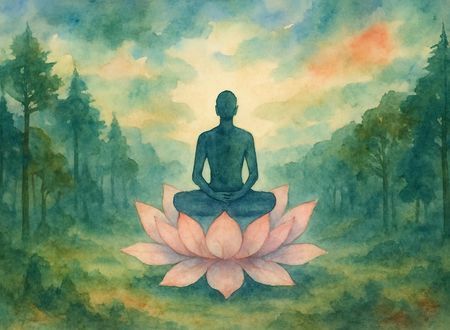
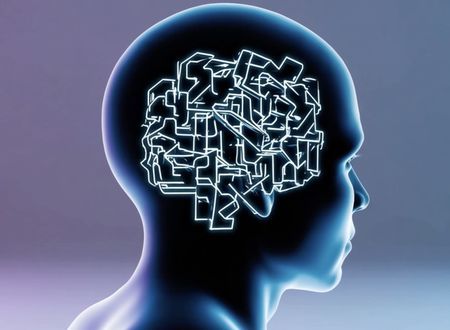

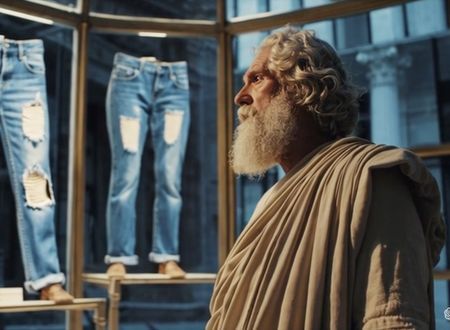
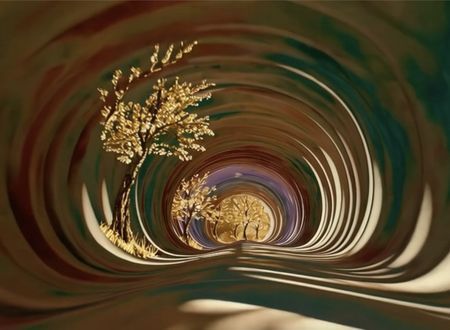


Comments & Discussion
0 COMMENTS
Please login to read members' comments and participate in the discussion.